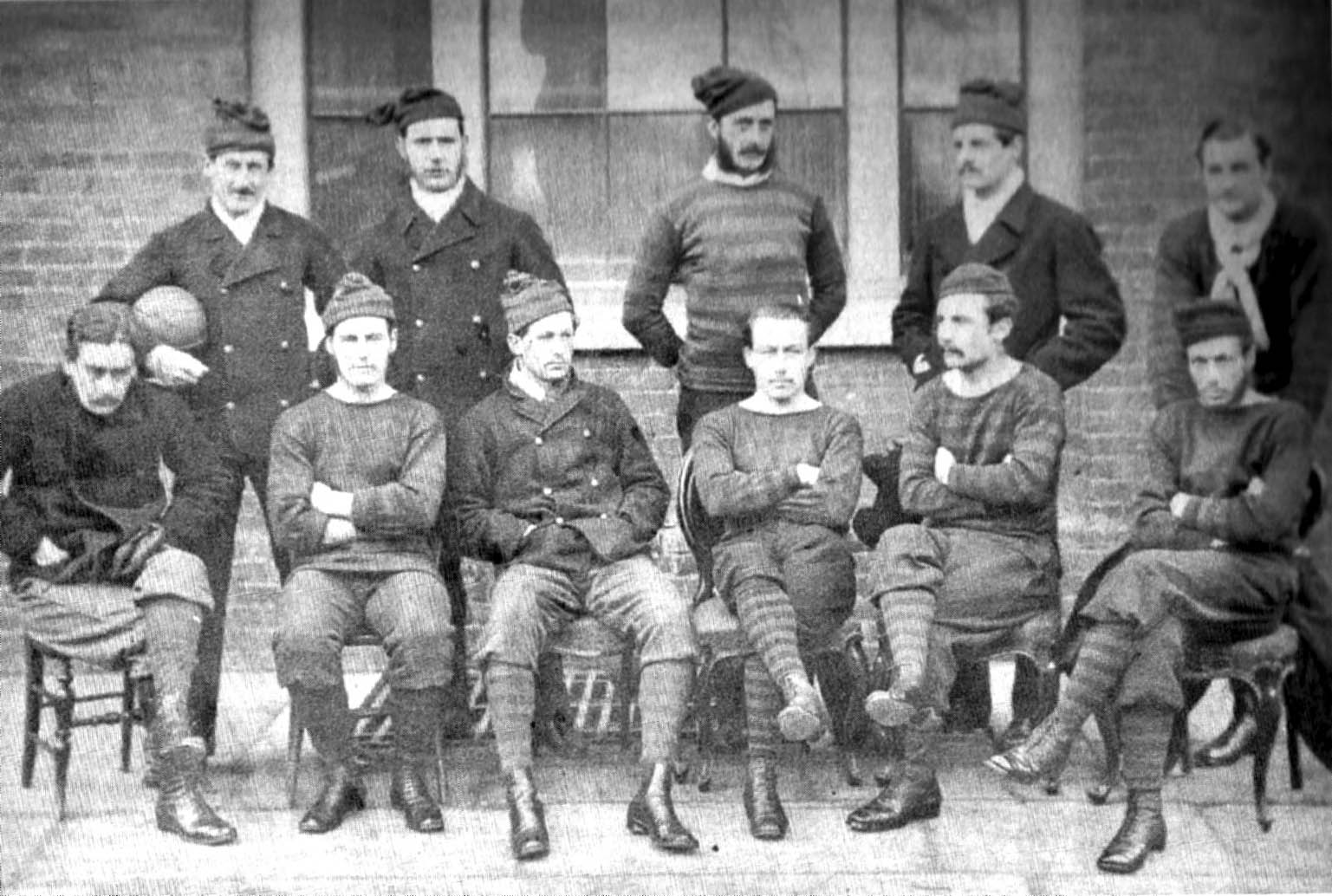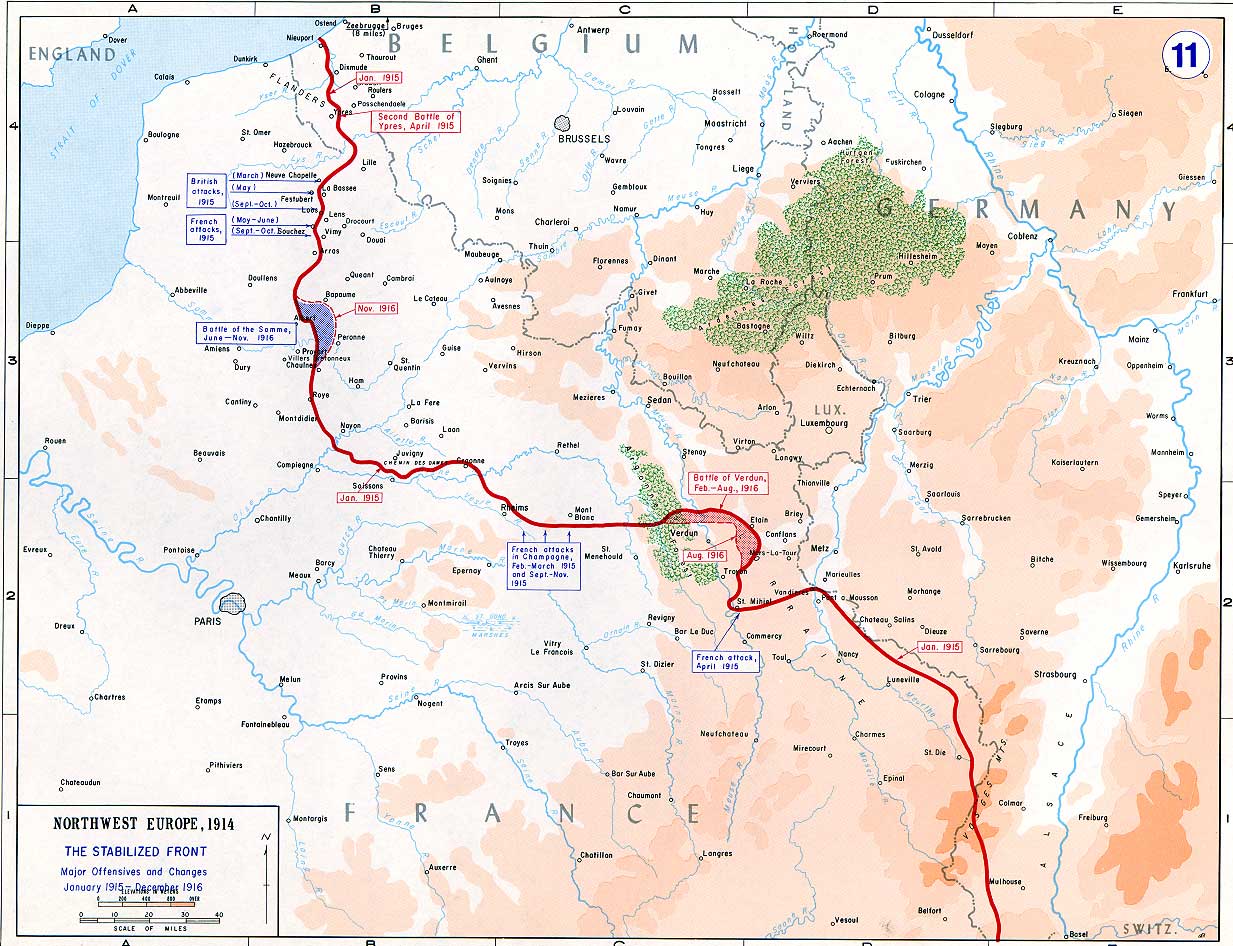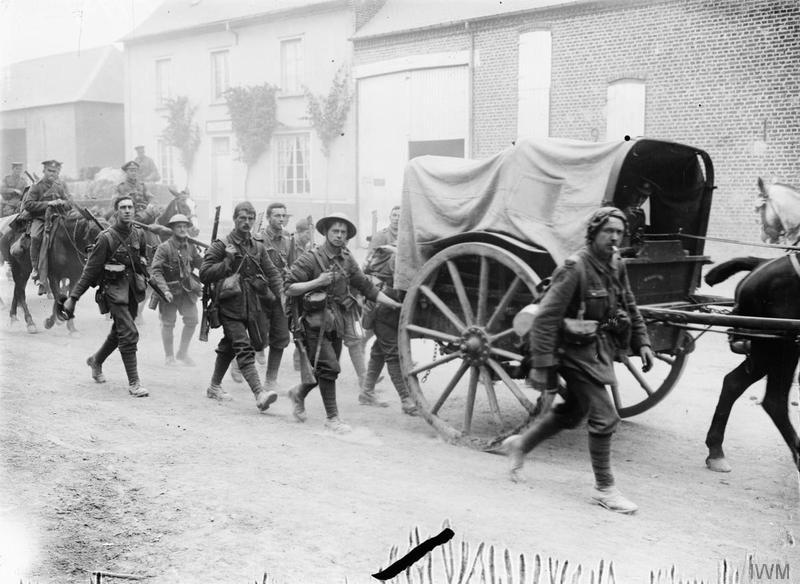|
Cecil Wingfield-Stratford
Brigadier-General Cecil Vernon Wingfield-Stratford CB, CMG (7 October 1853 – 5 February 1939) was a British Army officer in the Royal Engineers and an English international footballer who played as a forward. Early life Born in West Malling, Wingfield-Stratford was educated at the Royal Military Academy, Woolwich, a descendant of the ancient Stratford Family. He married Rosalind Isabel Bligh, daughter of Reverend Hon. Edward Vesey Bligh and Lady Isabel Mary Frances Nevill, on 12 October 1881. They had one son, Esmé Cecil Wingfield-Stratford. Sporting career Wingfield-Stratford played as outside-left for the Woolwich Academy and for Royal Engineers, and earned one cap for England versus Scotland in 1877. He was described by C.W. Alcock as "very fast and useful as a wing; wants a little more 'last' resumably meaning staying-power" He took part in the replayed 1875 FA Cup Final, both matches taking place at Kennington Oval when his team won the Final for their only time, ... [...More Info...] [...Related Items...] OR: [Wikipedia] [Google] [Baidu] |
West Malling
West Malling ( , historically Town Malling) is a market town in the Tonbridge and Malling district of Kent, England. It has a population of 2,590. Landmarks West Malling contains several historic buildings, including St Leonard's Tower, a Norman keep built by Bishop Gundulf (bishop between 1077 and 1108). He also built the White Tower of the Tower of London, the castles of Rochester and Colchester, and the Priory and Cathedral of Rochester. In c.1090 Gundulf founded St. Mary's Abbey in West Malling for Benedictine nuns. This historic site contains significant buildings from the Norman, medieval, Tudor and Georgian eras. There is also a Grade II* Listed 1966 abbey church which is used by the Anglican Benedictine nuns who have made Malling Abbey their home since 1916. Other buildings of interest in West Malling include the Prior's House, once a residence for those with leprosy; Ford House, over 600 years old; a mainly Georgian High Street; the Swan Hotel, an 18th-century co ... [...More Info...] [...Related Items...] OR: [Wikipedia] [Google] [Baidu] |
Henry Waugh Renny-Tailyour
Henry Waugh Renny-Tailyour (9 October 1849 – 15 June 1920) was a British amateur all-round sportsman who appeared for Scotland in some of the earliest international football and rugby union matches, remaining to this day the only player to have represented the country in both codes. He also played first class cricket for Kent County Cricket Club and was an accomplished athlete. Biography Renny-Tailyour was born at Mussoorie, North-Western Provinces (now in Uttarakhand) in what was then British India, while his Scottish father was serving in the army there. He grew up on the family estate at Newmanswalls, Montrose, Angus, and was educated at Cheltenham College before entering the British Army, joining the Royal Engineers.Renny-Tailyour, Colonel Henry Waugh Obituaries in 1921, '' [...More Info...] [...Related Items...] OR: [Wikipedia] [Google] [Baidu] |
England International Footballers
The England national football team represents the country of England in international association football. It is fielded by The Football Association, the governing body of football in England, and competes as a member of the Union of European Football Associations (UEFA), which encompasses the countries of Europe. England competed in the first official international football match on 30 November 1872, a 0–0 draw with Scotland at Hamilton Crescent. England have competed in numerous competitions, and all players who have played in 10 or more matches, either as a member of the starting eleven or as a substitute, are listed below. Each player's details include his playing position while with the team, the number of caps earned and goals scored in all international matches, and details of the first and most recent matches played in. The names are initially ordered by number of caps (in descending order), then by date of debut, then by alphabetical order. All statistics ar ... [...More Info...] [...Related Items...] OR: [Wikipedia] [Google] [Baidu] |
Companions Of The Order Of The Bath
The Most Honourable Order of the Bath is a British order of chivalry founded by George I on 18 May 1725. The name derives from the elaborate medieval ceremony for appointing a knight, which involved bathing (as a symbol of purification) as one of its elements. The knights so created were known as "Knights of the Bath". George I "erected the Knights of the Bath into a regular Military Order". He did not (as is commonly believed) revive the Order of the Bath, since it had never previously existed as an Order, in the sense of a body of knights who were governed by a set of statutes and whose numbers were replenished when vacancies occurred. The Order consists of the Sovereign (currently King Charles III), the Great Master (currently vacant) and three Classes of members: *Knight Grand Cross ( GCB) ''or'' Dame Grand Cross ( GCB) *Knight Commander ( KCB) ''or'' Dame Commander ( DCB) *Companion ( CB) Members belong to either the Civil or the Military Division.''Statutes'' 1925, ... [...More Info...] [...Related Items...] OR: [Wikipedia] [Google] [Baidu] |
Companions Of The Order Of St Michael And St George
Companion may refer to: Relationships Currently * Any of several interpersonal relationships such as friend or acquaintance * A domestic partner, akin to a spouse * Sober companion, an addiction treatment coach * Companion (caregiving), a caregiver, such as a nurse assistant, paid to give a patient one-on-one attention Historically * A concubine, a long-term sexual partner not accorded the status of marriage * Lady's companion, a historic term for a genteel woman who was paid to live with a woman of rank or wealth * Companion cavalry, the elite cavalry of Alexander the Great * Foot Companion, the primary type of soldier in the army of Alexander the Great * Companions of William the Conqueror, those who took part in the Norman conquest of England * Muhammad's companions, the Sahaba, the friends who surrounded the prophet of Islam Film and television * Companion (''Doctor Who''), a character who travels with the Doctor in the TV series ''Doctor Who'' * Companion (''Firefly ... [...More Info...] [...Related Items...] OR: [Wikipedia] [Google] [Baidu] |
Association Football Forwards
Association may refer to: * Club (organization), an association of two or more people united by a common interest or goal * Trade association, an organization founded and funded by businesses that operate in a specific industry * Voluntary association, a body formed by individuals to accomplish a purpose, usually as volunteers Association in various fields of study * Association (archaeology), the close relationship between objects or contexts. * Association (astronomy), combined or co-added group of astronomical exposures *Association (chemistry) * Association (ecology), a type of ecological community * Genetic association, when one or more genotypes within a population co-occur *Association (object-oriented programming), defines a relationship between classes of objects * Association (psychology), a connection between two or more concepts in the mind or imagination * Association (statistics), a statistical relationship between two variables * File association, associates a file ... [...More Info...] [...Related Items...] OR: [Wikipedia] [Google] [Baidu] |
1939 Deaths
This year also marks the start of the Second World War, the largest and deadliest conflict in human history. Events Below, the events of World War II have the "WWII" prefix. January * January 1 ** Third Reich *** Jews are forbidden to work with Germans. *** The Youth Protection Act was passed on April 30, 1938 and the Working Hours Regulations came into effect. *** The Jews name change decree has gone into effect. ** The rest of the world *** In Spain, it becomes a duty of all young women under 25 to complete compulsory work service for one year. *** First edition of the Vienna New Year's Concert. *** The company of technology and manufacturing scientific instruments Hewlett-Packard, was founded in a garage in Palo Alto, California, by William (Bill) Hewlett and David Packard. This garage is now considered the birthplace of Silicon Valley. *** Sydney, in Australia, records temperature of 45 ˚C, the highest record for the city. *** Philipp Etter took over ... [...More Info...] [...Related Items...] OR: [Wikipedia] [Google] [Baidu] |
1853 Births
Events January–March * January 6 – Florida Governor Thomas Brown signs legislation that provides public support for the new East Florida Seminary, leading to the establishment of the University of Florida. * January 8 – Taiping Rebellion: Zeng Guofan is ordered to assist the governor of Hunan in organising a militia force to search for local bandits. * January 12 – Taiping Rebellion: The Taiping army occupies Wuchang. * January 19 – Giuseppe Verdi's opera '' Il Trovatore'' premieres in performance at Teatro Apollo in Rome. * February 10 – Taiping Rebellion: Taiping forces assemble at Hanyang, Hankou, and Wuchang, for the march on Nanjing. * February 12 – The city of Puerto Montt is founded in the Reloncaví Sound, Chile. * February 22 – Washington University in St. Louis is founded as Eliot Seminary. * March – The clothing company Levi Strauss & Co. is founded in the United States. * March 4 – Inauguration of Franklin Pierce as 14t ... [...More Info...] [...Related Items...] OR: [Wikipedia] [Google] [Baidu] |
North Midland Divisional Engineers
The North Midland Divisional Engineers was a Territorial Force unit of the British Royal Engineers created in 1908 by conversion of a volunteer infantry battalion from Staffordshire. It saw action in World War I at the action of the Hohenzollern Redoubt, Hohenzollern Redoubt, First Day of the Somme, Gommecourt, Battle of Passchendaele, Ypres, Battle of Cambrai (1917), Cambrai, the German spring offensive and the Hundred Days Offensive, culminating in the assault crossings of the Battle of St. Quentin Canal, St Quentin Canal, the Battle of the Selle, Selle and the Battle of the Sambre (1918), Sambre. During World War II its component units saw action in the Battle of France, in Greek Campaign, Greece, Tunisian Campaign, Tunisia, Italian Campaign (World War II), Italy, Operation Overlord, Normandy and the Operation Plunder, Rhine crossing. Early history The origin of the unit lay in the 1st Staffordshire Rifle Volunteer Corps, one of many such RVCs raised after an invasion scare in ... [...More Info...] [...Related Items...] OR: [Wikipedia] [Google] [Baidu] |
Battle Of The Somme
The Battle of the Somme (French: Bataille de la Somme), also known as the Somme offensive, was a battle of the First World War fought by the armies of the British Empire and French Third Republic against the German Empire. It took place between 1 July and 18 November 1916 on both sides of the upper reaches of the Somme, a river in France. The battle was intended to hasten a victory for the Allies. More than three million men fought in the battle of whom one million were wounded or killed, making it one of the deadliest battles in human history. The French and British had committed themselves to an offensive on the Somme during the Chantilly Conference in December 1915. The Allies agreed upon a strategy of combined offensives against the Central Powers in 1916 by the French, Russian, British and Italian armies, with the Somme offensive as the Franco-British contribution. Initial plans called for the French army to undertake the main part of the Somme offensive, supported ... [...More Info...] [...Related Items...] OR: [Wikipedia] [Google] [Baidu] |
Attack On The Gommecourt Salient
The Attack on the Gommecourt Salient was a British operation against the northern flank of the German 2nd Army. The attack took place on 1 July 1916, on the Western Front in France, during the First World War. The attack was conducted by the British Third Army (Lieutenant-General Edmund Allenby) as a diversion, to protect the northern flank of the main attack. The British Fourth Army on the First day on the Somme, attacked from Serre southwards to the boundary with the French Sixth Army at Maricourt. To extend the attack front of the Fourth Army, the VII Corps (Lieutenant-General Thomas Snow) of the Third Army was to capture the Gommecourt Salient, the most westerly point of the Western Front. In the first week of May, the 56th (1/1st London) Division ( Major-General Charles Hull) and the 46th (North Midland) Division (Major-General Edward Montagu-Stuart-Wortley) moved into the area for the attack. By 10 May, both divisions had taken over the front on the right flank o ... [...More Info...] [...Related Items...] OR: [Wikipedia] [Google] [Baidu] |
Battle Of Loos
The Battle of Loos took place from 1915 in France on the Western Front, during the First World War. It was the biggest British attack of 1915, the first time that the British used poison gas and the first mass engagement of New Army units. The French and British tried to break through the German defences in Artois and Champagne and restore a war of movement. Despite improved methods, more ammunition and better equipment, the Franco-British attacks were largely contained by the Germans, except for local losses of ground. The British gas attack failed to neutralize the defenders and the artillery bombardment was too short to destroy the barbed wire or machine gun nests. German tactical defensive proficiency was still dramatically superior to the British offensive planning and doctrine, resulting in a British defeat. Background Strategic developments The battle was the British part of the Third Battle of Artois, an Anglo-French offensive (known to the Germans as the (Autumn Ba ... [...More Info...] [...Related Items...] OR: [Wikipedia] [Google] [Baidu] |



.jpg)



